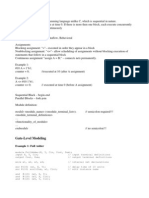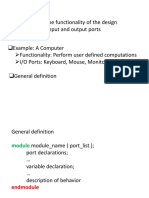0 ratings0% found this document useful (0 votes)
162 viewsVerilog Syntax Cheat Sheet: - Data Formats: - Modules
The document provides a cheat sheet overview of Verilog syntax including data formats, operations, modules, instantiation, constructs like if/else and case statements, variable declaration, bit manipulation, and more. Key elements covered are standard data format syntax using widths and bases, common logical, shift, arithmetic, and comparison operations, defining and instantiating modules with ports and parameters, always and initial blocks for sequential and combinational logic, and declaring vectors, arrays, and manipulating bits.
Uploaded by
Mohamed ElsahatCopyright
© © All Rights Reserved
Available Formats
Download as PDF, TXT or read online on Scribd
0 ratings0% found this document useful (0 votes)
162 viewsVerilog Syntax Cheat Sheet: - Data Formats: - Modules
The document provides a cheat sheet overview of Verilog syntax including data formats, operations, modules, instantiation, constructs like if/else and case statements, variable declaration, bit manipulation, and more. Key elements covered are standard data format syntax using widths and bases, common logical, shift, arithmetic, and comparison operations, defining and instantiating modules with ports and parameters, always and initial blocks for sequential and combinational logic, and declaring vectors, arrays, and manipulating bits.
Uploaded by
Mohamed ElsahatCopyright
© © All Rights Reserved
Available Formats
Download as PDF, TXT or read online on Scribd
You are on page 1/ 2
Verilog Syntax Cheat Sheet
- Data Formats: - Modules
- Standard Syntax: [WIDTH]'[BASE][VALUE] - Encapsulate blocks of logic into a reusable
- Example: 16'ha; -> 16 bit field, value of 0x000a container with a well-defined interface
- Bases: d = decimal, b = binary, h = hex - Example: module adder
- Strings treated as 1 byte-per-character #(
- Operations parameter WIDTH = 16
- Bitwise )
- Example: 3’b010 | 3’b110 -> 3’b111 [OR] (
3’b101 & 3’b100 -> 3’b100 [AND] input [WIDTH-1:0] a; // Signals In
3’b101 ^ 3’b100 -> 3’b001 [XOR] input [WIDTH-1:0] b;
~3’b010 -> 3’b101 [NOT] output [WIDTH:0] sum; // Signals Out
- Shifts output overflow;
- Example 4’b0111 << 1 -> 4’b1110 [Left Shift] );
4’b1111 >> 1 -> 4’b0111 [Right Shift]
- Arithmetic // Logic Goes Here
- Example: 3’b010 + 3’b100 -> 3’b110 [Addition] endmodule;
3’b100 – 3’b001 -> 3’b011 [Subtraction] - Instantiating Modules
- Comparators - Example: adder // Module Name
- Example: 3’b100 > 3’b011 -> 1’b1 [Greater Than] #( .WIDTH (16) )
3’b100 == 3’b010 -> 1’b0 [Equal To] adderInst // Instance Name
3’b100 != 3’b000 -> 1’b1 [Not Equal To] ( .a (w_a),
- Wires and Regs // Port b is attached to wire w_b
- Wires .b (w_b),
- Continuous assignments; do not "hold value" .sum (w_sum),
- Typically used for combinatorial logic assignment .overflow (w_overflow) );
- If unassigned, dflt value is 'z' (high impedance) - Constructs
- Use w/ 'assign' Statements - If/Else
- Example: assign z = x & y; - Example: always@(posedge clk) begin
assign w = z | v; if (y)
- z updates whenever x and y update x <= v;
w updates whenever z or v updates else if (w)
- Regs x <= w;
- Hold prior value until sensitivity list fires else
- A register does not always imply a flip-flop x <= x;
- Often used for clocked logic (i.e. registers) end
- Has a default value of ‘x’ (unknown) if unassigned - If...Else cases imply priority and are evaluated
- Example: always@(posedge clk) begin sequentially
if (rst) - Case Statements
q <= '0; - Example: // Combinatorial Logic
else always@(*) begin
q <= y; case (x)
end 1'b0:
- Triggered on positive edge of each clock y <= v;
- ‘q’ synthesizes as a register 1'b1:
- For best results you should only assign a reg in a y <= w;
single process default:
- Use ‘<=’ in processes to assign to regs. y <= '0;
- Variable declaration (Scalars, 2d Arrays) endcase
- Types end
- Single Bits: - This should resolve to a 2-to-1 Mux. 'x' is
- Ex: wire x; reg y; // 1 Bit Each the select line. v/w are Inputs
- Bit Vectors - ‘default’ case is not strictly necessary here
- Ex: wire [2:0] x; reg [2:0] y; // 3 Bits Each since all combinations are covered. It is best
- 2d Vectors practice to include it though.
- Ex: wire [7:0] x [3:0] // 4x8 Entries
- Bit Manipulation
- Bit Slicing
- Example: reg [15:0] data; wire [7:0] field;
// Take Lower 8 Bits of Data
assign field = data[7:0];
- Bit Concatenation
- Example: reg [15:0] data; wire [7:0] field;
// Flip the Nibbles
assign field = {data[3:0], data[7:4]};
- Array Indexing
- Example: wire [7:0] x [3:0]
x[0] // 8 Bit Entry at Array Idx 0
x[1][3:0] // Lower 4 Bits of Idx 1
Verilog Syntax Cheat Sheet
You might also like
- Credit Card Generator & Validator - Valid Visa Numbers - CardGuru0% (1)Credit Card Generator & Validator - Valid Visa Numbers - CardGuru8 pages
- Lesson - 5 Finding The Percent, Rate and Base in A Given Problem88% (8)Lesson - 5 Finding The Percent, Rate and Base in A Given Problem7 pages
- Aircraft Maintenance Manual Aircraft Maintenance Manual Aircraft Maintenance Manual Aircraft Maintenance ManualNo ratings yetAircraft Maintenance Manual Aircraft Maintenance Manual Aircraft Maintenance Manual Aircraft Maintenance Manual173 pages
- ECE241H1 - 20199 - 661580945892ECE241 Midterm Cheat SheetNo ratings yetECE241H1 - 20199 - 661580945892ECE241 Midterm Cheat Sheet2 pages
- Why Use The IEEE 1500 Standard?: 2.1.1 Test Reuse and PartitioningNo ratings yetWhy Use The IEEE 1500 Standard?: 2.1.1 Test Reuse and Partitioning8 pages
- Objective:: To Design A 2X1 MUX Using Logic GatesNo ratings yetObjective:: To Design A 2X1 MUX Using Logic Gates6 pages
- Ahb-Lite To Apb Protocol: BY Shraddha Devaiya EC - 018 Anand Therattil EC - 092No ratings yetAhb-Lite To Apb Protocol: BY Shraddha Devaiya EC - 018 Anand Therattil EC - 09229 pages
- Module-2, Session-1 HDL Design Concepts and RTL Coding With VHDLNo ratings yetModule-2, Session-1 HDL Design Concepts and RTL Coding With VHDL7 pages
- VLSI Design Verification and Testing: Fault SimulationNo ratings yetVLSI Design Verification and Testing: Fault Simulation5 pages
- 1.IJECE-UVM Based Verification of Dual Port SRAM by Implementing BISTNo ratings yet1.IJECE-UVM Based Verification of Dual Port SRAM by Implementing BIST8 pages
- (Ebook - PDF) Synthesizable Verilog-HDL Code - Circuit DesignNo ratings yet(Ebook - PDF) Synthesizable Verilog-HDL Code - Circuit Design63 pages
- Qdoc - Tips Dse Ingepac Ef LD Eng (35page)No ratings yetQdoc - Tips Dse Ingepac Ef LD Eng (35page)35 pages
- 2020 Hitachi Electric Chain Hoist - Product SheetNo ratings yet2020 Hitachi Electric Chain Hoist - Product Sheet5 pages
- Report - Advanced Electronic Voting Machine Using Finger Print ModuleNo ratings yetReport - Advanced Electronic Voting Machine Using Finger Print Module56 pages
- 98-99 LS400 Owners Manual Dash Light MeaningsNo ratings yet98-99 LS400 Owners Manual Dash Light Meanings10 pages
- Lesson 4 Data, Data Analysis, Database, Database ManagementNo ratings yetLesson 4 Data, Data Analysis, Database, Database Management42 pages
- i.MX6Q: i.MX 6quad Processors - High-Performance, 3D Graphics, HD Video, Arm Cortex - A9 CoreNo ratings yeti.MX6Q: i.MX 6quad Processors - High-Performance, 3D Graphics, HD Video, Arm Cortex - A9 Core5 pages
- Tribhuvan University Institute of Engineering Pulchowk CampusNo ratings yetTribhuvan University Institute of Engineering Pulchowk Campus21 pages
- Lecture 4 Sensitivity-374225-16754388280675No ratings yetLecture 4 Sensitivity-374225-1675438828067554 pages
- Method Statement For Installation of Epoxy Grout SleeveNo ratings yetMethod Statement For Installation of Epoxy Grout Sleeve5 pages
- 5S Management Audit Form - Canteen and Offices Rev 2100% (1)5S Management Audit Form - Canteen and Offices Rev 28 pages

























































































